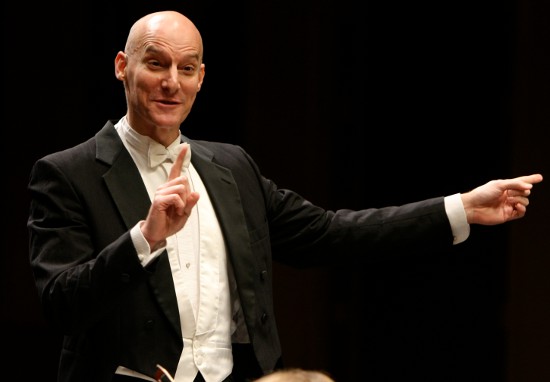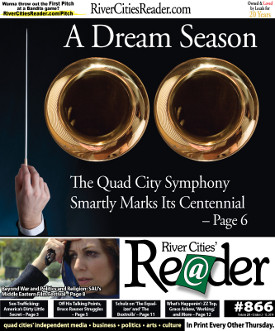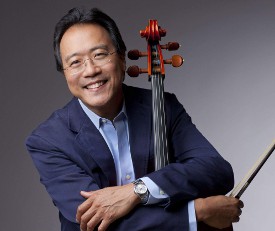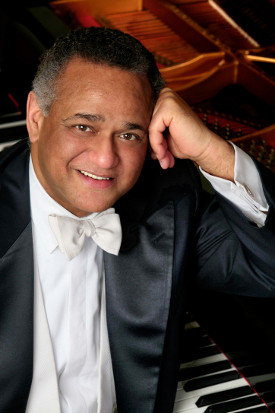
Looking despondent, the young conductor was comforted by his mentor. "Think of it this way, my son," the old maestro began. "If everyone was equally dissatisfied with your repertoire, at least you gave them a balanced season."
It's an old joke, but it sarcastically underscores the futility of finding music that will satisfy everyone.
But, in the Quad City Symphony's 100th season, Music Director and Conductor Mark Russell Smith has fashioned a carefully considered, diversely adventuresome musical celebration that includes a balanced sampling of masterpieces, premieres of six new commissioned works, and guest soloists ranging from world-class recording artists to members of the orchestra.
It's a dream season that lies ahead, but it's been an evolutionary process for Smith to get there.
Building on What Works
 Over the past three years, I've watched and listened as Smith experimented with musical and conceptual ideas for concerts - some more successful than others. The 2014-15 season expands upon the best aspects of recent seasons while removing those that didn't work.
Over the past three years, I've watched and listened as Smith experimented with musical and conceptual ideas for concerts - some more successful than others. The 2014-15 season expands upon the best aspects of recent seasons while removing those that didn't work.
Notably absent from the upcoming season are concert versions of opera, themed programs, and attempts to merge popular music into the Masterworks format.
Opera excerpts in the 2011-12 and 2012-13 seasons had radiant moments but were awkwardly staged and suffered from balance problems.
A season of themed concerts in 2012-13 was an interesting idea, but the selections represented a narrow stylistic period and didn't result in musically balanced programs.
Also in 2012-13, turning the February concerts into Valentine's Day pops programs diluted the quantity of classical music in the Masterworks series and taught planners that microphones can amplify problems.
Those ideas have been replaced in the centennial season with music that clarifies and fortifies the concept and artistic implications of the Masterworks series name. The upcoming repertoire also draws from recent season strengths.
In 2011-12, the series spanned 300 years of stylistic development - from the Baroque of Vivaldi to contemporary American composer Michael Abels.
That season also had Benjamin Britten's massive and logistically challenging War Requiem - an example of a maestro on a mission that showed the Quad City Symphony capable of working persuasively on a larger scale and with greater complexity. That undertaking arguably paved the way for similarly grand thinking: Stravinsky's Rite of Spring in 2012-13 and Mahler's Symphony No. 3 in 2013-14.
The 2013-14 season featured a welcome emphasis on American music with Samuel Barber, commissions from Michael Torke and Jacob Bancks, and the contemporary symphonic music of Aaron Jay Kernis and Jennifer Higdon.
Each of those can be clearly seen in the 2014-15 season: a variety similar to that of 2011-12, with a broad historical and cultural diversity; new commissions from American composers; and, in Beethoven's Ninth, an appropriately bold vision.
Great Examples of the Symphonic Form
This centennial season, the musical center stage will be occupied by a balanced assortment of iconic musical masterpieces. All symphonies, yet distinctly differentiated by culturally unique musical characteristics. They are arguably the best examples of symphonies from Dvo?ák, Tchaikovsky, Bruckner, Harris, Beethoven, and Mozart - representing music from the Czech Republic (Bohemia), Russia, Austria, the United States, and Germany.
Antonín Dvo?ák was a paradox as a composer, using urbane musical form and development but also the unsophisticated folk tunes of his rural home; he was an intuitive genius with the heart of a peasant. In the season-opening October concerts, there is a connection between the prairie of Iowa and the rolling hills of Bohemia. His tuneful Ninth Symphony - From the New World was influenced by folk music from America and Bohemia and is one of the most popular and often played pieces in the symphonic catalog.
Dvo?ák wrote it during the winter and spring of 1893 as director of the National Conservatory of Music of America. During the summer of that year, he packed up his family and traveled to Spillville, Iowa, to visit relatives and countrymen who had immigrated earlier, but also to finish scoring his new work. Leonard Bernstein called it "an international symphony," revealing not only Dvo?ák's roots but ours as well.
Pyotr Tchaikovsky's last symphony, The Pathetique, will be featured in November's concerts. An oscillation between triumph and despair, it is the musical melodrama of Tchaikovsky's Russian soul at its best. Immediately, the low, foreboding bassoon moans a theme unlike the openings of his fourth and fifth symphonies. It warns of a darker, less-predictable musical trek whose outcome is uncertain, but it's more faithful to the emotions of a conflicted composer.
December's concerts showcase a piece that concisely synthesizes European musical thought: Mozart's 40th Symphony. Most people are familiar with stories of the composing prodigy playing all over the continent. But as audiences were listening to Mozart across Europe, he was also listening to them - their concert, dance, and opera music. Wherever he went, he absorbed the music around him and integrated the best ideas into his own music.
Put a church cathedral and Richard Wagner together and you get the great Austrian Romanticist Anton Bruckner's Symphony No. 4 - Romantic in the February concerts. The organist and teacher combined the grand vaults, spaces, and sounds of a cathedral with the influence of Wagnerian opera's medieval legends. Bruckner's result is music with towering pillars of heroic brass separated by reverberating, contemplative stretches of musical prayer.
The first great symphony in the burgeoning American style will be the centerpiece of the March concerts: Oklahoman Roy Harris' Symphony No. 3. The composer was determined to remain artistically truthful, in symphonic form, to his inspirations - jazz, syncopation, and broad expanses of dusty plains. Written in one long movement, Harris' third symphony made him a leading American composer with its premiere in 1939. Since then, the work has become "the most widely performed and recorded of all American symphonies," according to Neil Butterworth in his 1998 book The American Symphony.
The Quad City Symphony will fittingly end its centennial season in April with Ludwig van Beethoven's monumental Symphony No. 9 - The Choral. Music commentator Martin Bookspan wrote: "If ever there was a cosmic musical creation, this is it - a score so overwhelming in its vision and breadth that it transcends temporal, worldly affairs."
There are many reasons why the Ninth holds such esteem among music lovers, but musicologists note that it is the first use of the human voice in a symphony. Beethoven successfully combined the text of Friedrich Schiller's poem "Ode to Joy" with his inspired musical score. From its suspenseful opening measures to the first massive statement of its bold, direct theme, the raw tonal austerity of the music sets the stage for the climatic "brotherhood of man" message that eventually emerges.
An Investment in American Composers
In an innovative approach, Quad City Symphony-commissioned music will open each concert in the Masterworks series. Expect each piece to be brief, surprising, and probably lively. For me, this is the perfect way to begin a concert, when the air is fresh and uncluttered and I haven't heard anything that would set my mood.
The Masterworks commissions include new work from John Frantzen, concert and film composer from Maquoketa, Iowa (October); James Romig, professor of composition and theory at Western Illinois University (November); David Gompper, director of the Center for New Music at the University of Iowa (December); St. Ambrose University's William Campbell (March); and Lake Forest, Illinois, composer James Stephenson (April).
The symphony will also perform a commission from last season, Torke's Oracle, to open the February concert.
And on October 19, Jacob Bancks' new Five Pieces for Violin & Piano will premiere as part of the symphony's Signature Series.
These commissions represent an investment in American art music by supporting its composers and disseminating their music through performances.
But they also have the potential to raise the Quad City Symphony's national profile. Last season's premiere of Bancks' Rock Island Line was recently featured on public radio's Performance Today program.
Setting the Bar High
 A season's roster of soloists should be a mixture of world-class and aspiring talent - to set the bar high and provide a forum for challengers. And that's what the Quad City Symphony has done for its centennial.
A season's roster of soloists should be a mixture of world-class and aspiring talent - to set the bar high and provide a forum for challengers. And that's what the Quad City Symphony has done for its centennial.
Separate from the Masterwork's season - an add-on billed as a pops program but with classical music - cellist Yo-Yo Ma on May 14 will join the Quad City Symphony for a one-night-only performance of Dvo?ák's Cello Concerto.
Considered by most critics the world's preeminent cellist, Ma is also the world's best-known and best-selling classical recording artist - with 16 Grammys and more than 75 albums to his name.
Perhaps the most glorious aspect of Ma's music-making is the extent of his mystical communication - all those personal, beyond-words feelings he conveys in his playing; you stop thinking about anything else when you see him perform. His musical storytelling is so compelling because he lives the music with each measure, completely consumed in its creation. It becomes the only thing going on in the room.
Another world-class soloist opens the Masterworks season in October: pianist André Watts. A short time after his concerto debut at age 16 with Leonard Bernstein and the New York Philharmonic, Watts was called in at the last minute to replace the legendary Glenn Gould. This weekend, he'll step in to replace the ailing Garrick Ohlsson as the featured soloist for the Quad City Symphony and perform one of his signature pieces, Rachmaninoff's Second Piano Concerto. Music critic Ayuano Hodouchi wrote of Watts' Rachmaninoff with the New York Philharmonic: "Economy is not on Watts' agenda - he plays unstintingly, every little passage crafted with love and attention. His tones are warm and gleam like burnished gold."
In November, Minnesota Orchestra Concertmaster Erin Keefe joins the Quad City Symphony in a performance of Johannes Brahms' Violin Concerto. Renowned conductor Hans von Bulow, after its premiere in 1879, summarized that the "concerto was not written for the violin but against the violin." Keefe, however, has the chops to bring the Brahms under control. The Massachusetts Republican said: "Coupling ... technique and understanding with a winning persona and nerves of steel, Keefe clearly has a brilliant career ahead of her."
February's concerts introduce Chicago native and nationally recognized flutist Demarre McGill, playing Mozart's joyful Flute Concerto in G. Principal flute of the Dallas Symphony Orchestra, McGill has performed as a soloist with the Philadelphia, Pittsburgh, Seattle, San Diego, Baltimore, and Milwaukee symphony orchestras. The Seattle Sun Break wrote of McGill's sound: "Totally clean, liquid, mellifluous, ... rounded, and beautiful, it beckoned you in."
Joel Fan, who made his performing debut with the New York Philharmonic at age 11, returns to the Quad Cities in March, playing a toe-tapping program of American music including George Gershwin's tuneful, jazzy Rhapsody in Blue and Morton Gould's Interplay for Piano & Orchestra. David Weininger of the Boston Globe wrote: "Fan played with eloquence and sensitivity, phrasing lines in a natural, unhurried way." As a recording artist, Fan scored two consecutive Billboard Top 10 classical debuts with his solo CDs World Keys and West of the Sun.
 The season-finale concerts in April will feature four vocalists bringing Beethoven's timeless Symphony No. 9 to life: soprano Karen Slack, tenor Vale Rideout, bass baritone Dean Elzinga, and Quad Cities-based mezzo-soprano Eleni Matos.
The season-finale concerts in April will feature four vocalists bringing Beethoven's timeless Symphony No. 9 to life: soprano Karen Slack, tenor Vale Rideout, bass baritone Dean Elzinga, and Quad Cities-based mezzo-soprano Eleni Matos.
Matos is the winner of an unprecedented 33 national and international vocal competitions, including the Maria Callas, Luciano Pavaroti, Metropolitan Opera, and Caruso. She performed Beethoven's Symphony No. 9 with the Detroit Symphony as part of a PBS special, and she sang the Verdi Requiem at the foot of the Acropolis for the week-long remembrance of opera legend Maria Callas on Greek national television.
Slack's voice, according to Opera News, "is glorious ... in tone, generous in volume, flexible in tempo, and luminous on top," and San Francisco Classical Voice called it "crystal clear, yet with that smooth nuance of the sort heard from a Schwarzkopf or Te Kanawa. Her performance has major career stamped all over it."
Of Rideout's performance of Benjamin Britten's Serenade for Tenor & Horn, the New York Times wrote that his "luminous tenor voice has remarkable purity in the high range and is able to maintain an even polish across the dynamic range. With his excellent diction and natural, smooth-flowing delivery light on vibrato, he was an ideal match for Britten."
Elzinga, meanwhile, is one of the country's most-sought-after basses for Beethoven's Ninth, having performed it with the Minnesota Orchestra and dozens of other orchestras.
Joining the quartet in singing Shiller's "Ode to Joy" for the April concerts will be Quad City Choral Arts and the Handel Oratorio Society prepared by Jon Hurdy.
Those groups will also take their bow in a vocally and ear-challenging stroke of artistic insight. Written in 1907, almost a hundred years after Beethoven's Choral symphony, Arnold Schöberg's Friede auf Erden (Peace on Earth) for choir journeys from a first-verse depiction of the Nativity through a second telling of bloodshed and imploring angels. The third and fourth verses deliver the "peace" of the title. Schönberg's extended tonality, modern for its time, and the words by Conrad Meyer set the stage for Beethoven's powerful message of brotherhood that follows in his Ninth Symphony.
But the piece also provides a musical magnifying glass that reveals the depth of the choirs' training in a subtle, intimate a cappella setting - and it represents a symbolic union between our community and the Quad City Symphony.
That relationship will also be evident in the December concerts, showcasing some of the orchestra's principal players performing a variety of chamber music. They'll share their talent and musical insight as hundreds of other homegrown musicians have done over the years.
French Romantic Camille Saint-Saëns' Romance will highlight hornist Marc Zyla. The Classical style of Joseph Haydn's Sinfonia Concertante will feature violinist Naha Greenholtz, cellist Hannah Holman, oboist Andrew Parker, and bassoonist Benjamin Coehlo. And the French Impressionist Maurice Ravel's Introduction & Allegro will spotlight harpist Lillian Lau.
Giving soloist slots to members of the orchestra is stimulating for the audience but also an act of professional trust between the conductor and his players. After all, it's the orchestra members - more than the conductor, the administration, the board, or the audience - who are most responsible for the Quad City Symphony's century of music-making.
For more information on the Quad City Symphony, visit QCSymphony.com.
Frederick Morden is a retired orchestra-music director, conductor, composer, arranger, educator, and writer who has served on the executive board of the Conductors Guild. He can be reached at f.morden@mchsi.com.










